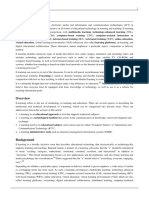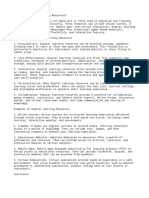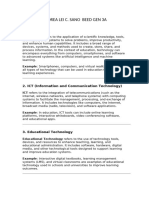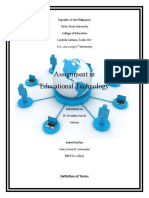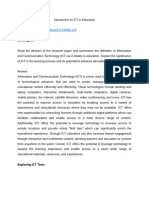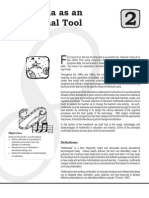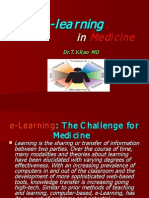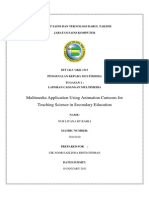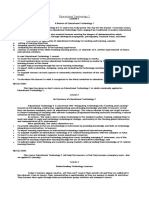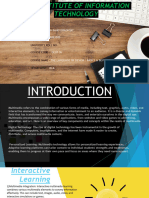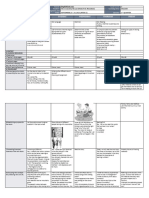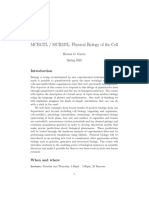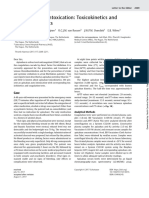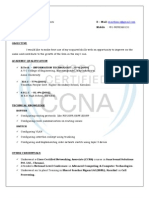Edutainment: Sub Topic
Edutainment: Sub Topic
Uploaded by
Zen MarkCopyright:
Available Formats
Edutainment: Sub Topic
Edutainment: Sub Topic
Uploaded by
Zen MarkOriginal Description:
Original Title
Copyright
Available Formats
Share this document
Did you find this document useful?
Is this content inappropriate?
Copyright:
Available Formats
Edutainment: Sub Topic
Edutainment: Sub Topic
Uploaded by
Zen MarkCopyright:
Available Formats
Chapter 2
Major topic 1 Edutainment Is any entertainment content that is designed to educate as well as to entertain. Content with a high degree of both educational and entertainment value is known as edutainment. There also exists content that is primarily educational but has incidental entertainment value. Finally, there is content that is mostly entertaining but can be seen to have some educational value. A fusion of education and entertainment, edutainment is defined by its entertainment value/focus. David Suzukis The Nature of Things on the CBC and the classic childrens game Where in the World is Carmen Sandiego? are great examples. In this context, it is a type of entertainment that may appear limited to just that: games, shows and films. In medical education it is often used in the form of games. We also see variations of this concept in the use of pictures and videos in lectures and cases to help illustrate points or make them somewhat humorous.
Sub Topic
1.1 E-Learning - refers to the use of electronic media and information and communication technologies (ICT) in education. E-learning is broadly inclusive of all forms of educational technology in learning and teaching. Elearning is inclusive of, and is broadly synonymous with multimedia learning, technology-enhanced learning (TEL), computer-based instruction (CBI), computer-based training (CBT),computer-assisted instruction or computer-aided instruction (CAI), internet-based training (IBT), web-based training (WBT),online education, virtual education, virtual learning environments (VLE) (which are also called learning platforms), m-learning, and digital educational collaboration. These alternative names emphasize a particular aspect, component or delivery method.
is a form of electronic media where data are stored in digital form. It can refer to the technical aspect of storage and transmission of information or to the "end product". Once
1.2 Digital Media for Edutainment -
digitized, media may be processed in a variety of ways using standard computer hardware and software or, where performance is critical, in high-performance digital hardware such as an ASIC. Processing can include editing, filtering and content creation. Access control devices. 1.3 Virtual reality in education - is a term that applies to computersimulated environments that can simulate physical presence in places in the real world, as well as in imaginary worlds. Most current virtual reality environments are primarily visual experiences, displayed either on a computer screen or through specialstereoscopic, but some simulations include additional sensory information, such as sound through speakers or headphones. Education is another area which has adopted virtual reality for teaching and learning situations. The advantage of this is that it enables large groups of students to interact with each other as well as within a three dimensional environment. It is able to present complex data in an accessible way to students which is both fun and easy to learn. Plus these students can interact with the objects in that environment in order to discover more about them.
1.4 Virtual learning Environments - is an e-learning education system based on the web that models conventional in-person education by providing equivalent virtual access to classes, class content, tests, homework, grades, assessments, and other external resources such as academic or museum website links. It is also a social space where students and teacher can interact through threaded discussions or chat. It typically uses Web 2.0 tools for 2-way interaction, and includes a content management system.
You might also like
- A Case Study On Critical Thinking, Creativity, Innovation and Collaboration Practices in Classroom Using Digital TechnologyDocument7 pagesA Case Study On Critical Thinking, Creativity, Innovation and Collaboration Practices in Classroom Using Digital TechnologyHaruno Aman KhatriNo ratings yet
- Technology For Teaching and Learning in The Elementary GradesDocument8 pagesTechnology For Teaching and Learning in The Elementary GradesGerwin VicenteNo ratings yet
- Math 4 Prelim CoverageDocument41 pagesMath 4 Prelim CoverageZen MarkNo ratings yet
- Event Management Quotation Template PDFDocument17 pagesEvent Management Quotation Template PDFVita PerdanaNo ratings yet
- Bringing The World Into The Classroom Through Educational TechnologyDocument5 pagesBringing The World Into The Classroom Through Educational TechnologyVolleyverseNo ratings yet
- Education in TechnoligyDocument11 pagesEducation in Technoligyabdullahlabib073No ratings yet
- E LearningDocument15 pagesE LearningTechie Harry100% (1)
- SIP ReportDocument25 pagesSIP ReportAfwan Mohammed afwan Mohammed0% (1)
- E Learning FactsDocument30 pagesE Learning FactsScarletBeauty Enriquez-DiagbelNo ratings yet
- Multimedia As Educational ToolDocument6 pagesMultimedia As Educational Toolaianab2386No ratings yet
- Up QuizDocument2 pagesUp QuizLloyd Jason MashizzleNo ratings yet
- E-Learning and Its Technologies Running Head: E-LearningDocument44 pagesE-Learning and Its Technologies Running Head: E-LearningWangari WaweruNo ratings yet
- E LearningDocument19 pagesE LearningShivinder SinghNo ratings yet
- Lesson 1-2 (EDUC 204)Document9 pagesLesson 1-2 (EDUC 204)Ella DavidNo ratings yet
- DmpilapilDocument19 pagesDmpilapilfries riveraNo ratings yet
- Online Assignment (1) TechDocument5 pagesOnline Assignment (1) TechAnonymous YgtSuWxNo ratings yet
- DownloadDocument285 pagesDownloadBlack BullsNo ratings yet
- ANDREA LEI C.docx TDocument3 pagesANDREA LEI C.docx TsanoandrealeiNo ratings yet
- Assignment in Educational TechnologyDocument7 pagesAssignment in Educational TechnologyAnkit TrivediNo ratings yet
- E-Learning - Wikipedia, The Free EncyclopediaDocument20 pagesE-Learning - Wikipedia, The Free EncyclopediakcwbsgNo ratings yet
- ICT and E - Learning ApproachesDocument7 pagesICT and E - Learning Approachesabdullahharoon974No ratings yet
- Introduction To E-LearningDocument11 pagesIntroduction To E-LearningMalliga Padmanaban100% (10)
- Home Work1Document4 pagesHome Work1Jeizbeth JeyNo ratings yet
- Unit 1 Introduction To Facilitating Training and Electronic MediaDocument5 pagesUnit 1 Introduction To Facilitating Training and Electronic MediaMa. Catherine Dayag - LadrillonoNo ratings yet
- Fadairo Anuoluwapo ProjectDocument47 pagesFadairo Anuoluwapo Projectafolabioluwafemi0228No ratings yet
- Archivocompendio 2023615161825Document10 pagesArchivocompendio 2023615161825SIRLEI DENISSE JIMENEZ ORDOÑEZNo ratings yet
- Technology, Learning, Language Learning, KkuDocument29 pagesTechnology, Learning, Language Learning, Kkuabdelfattah_mohNo ratings yet
- The Impact of Technology On Modern EducationDocument2 pagesThe Impact of Technology On Modern EducationYhani RomeroNo ratings yet
- Modern Tech of CommunicationDocument7 pagesModern Tech of Communicationvikram122No ratings yet
- Group 1 - Problems & Issues in Educ MNGTDocument39 pagesGroup 1 - Problems & Issues in Educ MNGTnorma johanna s. salamancaNo ratings yet
- Contemporary IssuesDocument3 pagesContemporary Issuesmhussainshigri786No ratings yet
- Multimedia As An Educational Tool: DefinitionsDocument5 pagesMultimedia As An Educational Tool: DefinitionsUkhuwah IslamiyahNo ratings yet
- Artticle7 Ver1Document3 pagesArtticle7 Ver1breakingb719No ratings yet
- Mount Carmel College of Teacher Education: KanjikuzhiDocument9 pagesMount Carmel College of Teacher Education: KanjikuzhiRoji MathewNo ratings yet
- Computer Media and LearningDocument2 pagesComputer Media and Learningstevewah4uNo ratings yet
- E LearningDocument58 pagesE Learningtummalapalli venkateswara rao100% (1)
- EDU 302Document14 pagesEDU 302Ustaz Abdul Lateef BabatundeNo ratings yet
- ReportDocument8 pagesReportSupreet KaurNo ratings yet
- Tugasku Ict SekaliiDocument8 pagesTugasku Ict SekaliiFriska WidyastutiNo ratings yet
- whatever 4Document4 pageswhatever 4Τάκης ΠρεφτίτσηςNo ratings yet
- TL1 Notes (1ST Sem - Midterm)Document9 pagesTL1 Notes (1ST Sem - Midterm)Julyah PicardalNo ratings yet
- Ted 07 Week 1 Lesson 1 2Document4 pagesTed 07 Week 1 Lesson 1 2Apple Rose canozaNo ratings yet
- Module 4 FinalDocument18 pagesModule 4 FinalkentmatthewperezNo ratings yet
- ICT-IN-EDUCATION-PDFDocument31 pagesICT-IN-EDUCATION-PDFpontinghassanNo ratings yet
- ILISAN EDFD 212 Management of Educational TechnologyDocument26 pagesILISAN EDFD 212 Management of Educational TechnologyPhili-Am I. OcliasaNo ratings yet
- EdTech - Introduction - Course OutlineDocument2 pagesEdTech - Introduction - Course Outlinecollegeofeducation161No ratings yet
- Multimedia Application Using Animation Cartoons For Teaching Science in Secondary EducationDocument15 pagesMultimedia Application Using Animation Cartoons For Teaching Science in Secondary EducationFaz LynndaNo ratings yet
- Educ 204 Midterm ReviewerDocument15 pagesEduc 204 Midterm ReviewerRea Marie Joy CalimlimNo ratings yet
- E-LEARNING 2020 BBCDocument9 pagesE-LEARNING 2020 BBCReagan SsebbaaleNo ratings yet
- Module Technology 1Document8 pagesModule Technology 1Catherine Ronquillo BalunsatNo ratings yet
- NORMA JOHANNA S. SALAMANCA TRENDS IN EDUCATION (EducMngt 310)Document37 pagesNORMA JOHANNA S. SALAMANCA TRENDS IN EDUCATION (EducMngt 310)norma johanna s. salamancaNo ratings yet
- Technology in The ClassroomDocument19 pagesTechnology in The ClassroomNelson PiojoNo ratings yet
- Cloud Computing Based E-Learning SystemDocument8 pagesCloud Computing Based E-Learning Systemannaicsdepartment100% (2)
- TTL MODULE-1-Lesson-4Document8 pagesTTL MODULE-1-Lesson-4Adora Paula M BangayNo ratings yet
- Ed 207 - TTL 1 Unit 4Document12 pagesEd 207 - TTL 1 Unit 4kimpeterjohnlebunaNo ratings yet
- Mes 56Document8 pagesMes 56AakashMalhotraNo ratings yet
- Essay Pgt201eDocument13 pagesEssay Pgt201eLiah TambulianNo ratings yet
- Educational Technology 2 SummaryDocument10 pagesEducational Technology 2 SummaryrinaNo ratings yet
- Bca2023042-Amritava BandyopadhyayDocument10 pagesBca2023042-Amritava Bandyopadhyaytumpamallick42121No ratings yet
- TTL1 (Review)Document14 pagesTTL1 (Review)Juila jean ManagaytayNo ratings yet
- ENGLISH-10 Q2 Mod1Document17 pagesENGLISH-10 Q2 Mod1Jadine SivillinoNo ratings yet
- IntroDocument8 pagesIntroZen MarkNo ratings yet
- Bataan Peninsula State University Associate in Technical Graphics Zen Mark T. Gaor 8Document1 pageBataan Peninsula State University Associate in Technical Graphics Zen Mark T. Gaor 8Zen MarkNo ratings yet
- Word ResumeDocument2 pagesWord ResumeZen MarkNo ratings yet
- Development of An Edutainment System With Interactors of A Teacher and A Student in Which A User Plays A Double Role of ThemDocument2 pagesDevelopment of An Edutainment System With Interactors of A Teacher and A Student in Which A User Plays A Double Role of ThemZen MarkNo ratings yet
- Resumae FormatDocument2 pagesResumae FormatZen MarkNo ratings yet
- The 3-Year Fast-Track PHD: DR Terence LoveDocument22 pagesThe 3-Year Fast-Track PHD: DR Terence LoveBecky VickyNo ratings yet
- Collage of Business and Economics Department of Management:: Hassen Ahmed: TeklayDocument48 pagesCollage of Business and Economics Department of Management:: Hassen Ahmed: TeklayEng-Mukhtaar CatooshNo ratings yet
- High Guardian Spice BoardsDocument152 pagesHigh Guardian Spice BoardsRaye Rodriguez100% (1)
- Syllabus Teaching Listening and SpeakingDocument3 pagesSyllabus Teaching Listening and Speakingdaviqr100% (5)
- Types of ManometersDocument3 pagesTypes of ManometersJeyvie Cabrera Odiame100% (9)
- ABM-APPLIED ECONOMICS 12 - Q1 - W4 - Mod4 PDFDocument22 pagesABM-APPLIED ECONOMICS 12 - Q1 - W4 - Mod4 PDFJessebel Dano Anthony83% (6)
- Future Perfect ContinuousDocument4 pagesFuture Perfect ContinuousadauNo ratings yet
- LSG Unit 1Document12 pagesLSG Unit 1smritig1199No ratings yet
- Birkett v. Law Society of OntarioDocument6 pagesBirkett v. Law Society of OntarioRounak VirmaniNo ratings yet
- Reclaiming Michigan's Throwaway Kids - Students Trapped in The School-to-Prison Pipeline by American Civil Liberties Union of MichiganDocument76 pagesReclaiming Michigan's Throwaway Kids - Students Trapped in The School-to-Prison Pipeline by American Civil Liberties Union of MichiganUrbanYouthJustice100% (1)
- GE 105 Lecture 4 (TRIANGULATION ADJUSTMENT) By: Broddett Bello AbatayoDocument20 pagesGE 105 Lecture 4 (TRIANGULATION ADJUSTMENT) By: Broddett Bello AbatayoBroddett Bello Abatayo100% (4)
- News Theme Music Fade in Establish Fade Under: Fast. Straight. PreciseDocument5 pagesNews Theme Music Fade in Establish Fade Under: Fast. Straight. PreciseCelestineNo ratings yet
- Sapagent711 InstallconfigDocument64 pagesSapagent711 InstallconfigmiceduNo ratings yet
- Foucault: Michel Foucault, An Interview With Stephen Riggins, Toronto, 1982Document4 pagesFoucault: Michel Foucault, An Interview With Stephen Riggins, Toronto, 1982Sabina StoynovaNo ratings yet
- Maratha EmpireDocument30 pagesMaratha EmpireAdam Bin Mat RofiNo ratings yet
- Caribbean Examinations Council: SEA/20O9Document31 pagesCaribbean Examinations Council: SEA/20O9Anna Del Rey ValtersenNo ratings yet
- 2B Typicalfriends: 1k 1yes, I DoDocument1 page2B Typicalfriends: 1k 1yes, I DoE. CLNo ratings yet
- Restaurent PlanDocument17 pagesRestaurent PlanSanjay MathurNo ratings yet
- DLL - English 5 - Q1 - W5Document8 pagesDLL - English 5 - Q1 - W5Jessa ValderamaNo ratings yet
- Jurnal 2Document6 pagesJurnal 2IrdaniatiNo ratings yet
- MCB 137L SyllabusDocument6 pagesMCB 137L SyllabusJulianna LammNo ratings yet
- Process of CommunicationDocument21 pagesProcess of CommunicationGeetanjali MishraNo ratings yet
- Intoxicación Por ApixabanDocument3 pagesIntoxicación Por ApixabanMariana fotos FotosNo ratings yet
- PSAT 2019 Spring AnswersDocument20 pagesPSAT 2019 Spring Answersnikes 1100% (3)
- The Phoenix GroupDocument16 pagesThe Phoenix Groupionvidrascu2013No ratings yet
- KMC - GEC Semester I (2023-24) - Final List : Botany: Protected Agriculture - Hydroponics and Organic CultivationDocument135 pagesKMC - GEC Semester I (2023-24) - Final List : Botany: Protected Agriculture - Hydroponics and Organic CultivationdhingrakajitNo ratings yet
- Analysis of Non Prismatic Beams in BridgeDocument7 pagesAnalysis of Non Prismatic Beams in BridgeNafeez AhmedNo ratings yet
- English Vocab BookV2 FinalDocument9 pagesEnglish Vocab BookV2 FinalMaher FadelNo ratings yet
- Mohamed MasthanDocument2 pagesMohamed MasthanVinoth KrishNo ratings yet






